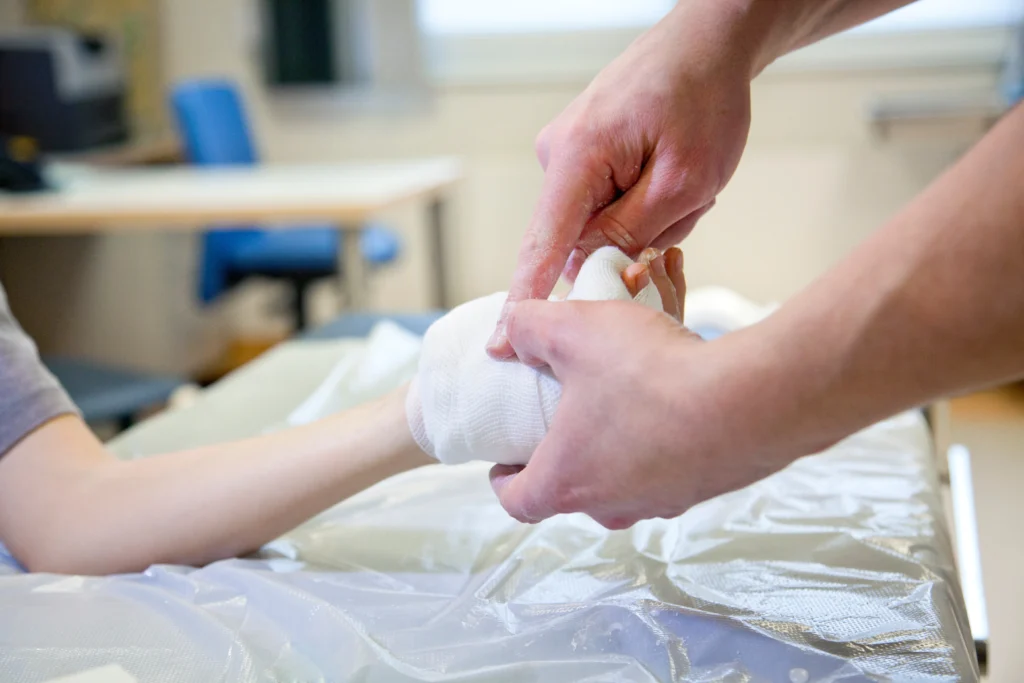Identifying A Sprain
Sprains can range from mild to severe. Mild sprains are a stretch or tiny tear in the fibers that make up the ligament. In a moderate sprain, the ligaments are partially torn. This type of injury may involve some loss of function. With a severe sprain, the ligament is completely torn or is pulled off its attachment to the bone. These are significant injuries that require medical or surgical care. If the ligament tears away from the bone, it may take a small chip of the bone with it. This is called an avulsion fracture.
What Are Ligaments?
Ligaments are strong, fibrous bands of tissues that cross joints and connect bones to other bones. The ligaments in the thumb help stabilize the joint and keep it in proper position. The most common thumb ligament that is sprained is the ulnar collateral ligament (UCL), which is located on the inside of the knuckle at the base. An acute injury to the UCL is often referred to as a “skier’s thumb”. The ligament can also be injured more gradually, over time, from repetitive grasping or twisting activities. This type of chronic injury is known as a “gamekeeper’s thumb.”
What Causes Thumb Sprains?
A thumb sprain occurs when the ligaments that support the base of the thumb are stretched or torn. This usually happens when a strong force bends the thumb backward, away from the palm, or to the side. The most common way for this to occur is by falling onto an outstretched hand that bends the thumb backward. Thumb sprains are common in skiers and athletes who participate in sports that involve catching and throwing a ball, like football, baseball, and basketball.
Signs Of A Sprain
Depending on the severity of the sprain, pain may or may not occur at the time of the injury. You may have bruising, tenderness, and swelling around the base of your thumb, near the palm. Your thumb joint may also feel loose or unstable. It may also weaken your ability to grasp objects between your thumb and index finger.
Diagnosing A Sprain
Proper diagnosis and treatment of a thumb injury are necessary to avoid long-term complications, including chronic pain, instability, and arthritis. Your doctor may order x-rays of your thumb and hand to ensure that you do not have an avulsion fracture or any broken bones. They may also take an x-ray of your uninjured thumb to compare it to the injured thumb.
Imaging For Sprains
A special type of X-ray called a stress X-ray, may also be ordered. During this test, your doctor will apply tension to your thumb while it is being x-rayed to learn more about the stability of the MCP joint. If more information is needed, a magnetic resonance imaging (MRI) scan or an ultrasound may be ordered. These tests can help your doctor learn more about the severity of your injury and make decisions regarding your treatment and return to activity.
Treating A Sprain
Treatment for a sprained thumb depends on the severity of the injury. Treatment usually involves wearing a brace or cast to keep the thumb from moving while the ligament heals. Depending on the severity of the injury, you may be instructed to wear the splint or cast at all times.
Surgery For Sprains
For a severe sprain or fracture, surgery may be needed to restore the stability of your thumb joint and help you regain function. Surgery involves reconnecting the ligament to the bone and/or repairing the avulsion fracture using a pin, screw, or special bone anchor. After surgery, you may have to wear a short arm cast or a splint for 6 to 12 weeks to protect the thumb ligament while it heals.
Healing A Sprain
When diagnosed and treated properly, most thumb sprains will heal well with no complications. However, a sprained thumb that is ignored with the hope that it will heal on its own may lead to long-term problems, including chronic instability, weakness, and arthritis.
Long-Term Complications From A Sprain
If these late complications develop, surgery may be needed to rebuild the ligament using tissue from your upper arm. If there is significant arthritis, a joint fusion procedure may be needed to address both the arthritis and the instability of the MCP joint.
When To See The Pediatric Orthopedic Center
If you feel your child is experiencing symptoms or signs related to this condition, it may be time to visit us. The Pediatric Orthopedic Center is the premier NJ hub for pediatric orthopedics, with four offices throughout northern NJ. Having been the leader in pediatric orthopedics in this area for over 25 years, we are the largest and most award-winning pediatric orthopedic practice in the tri-state area.



